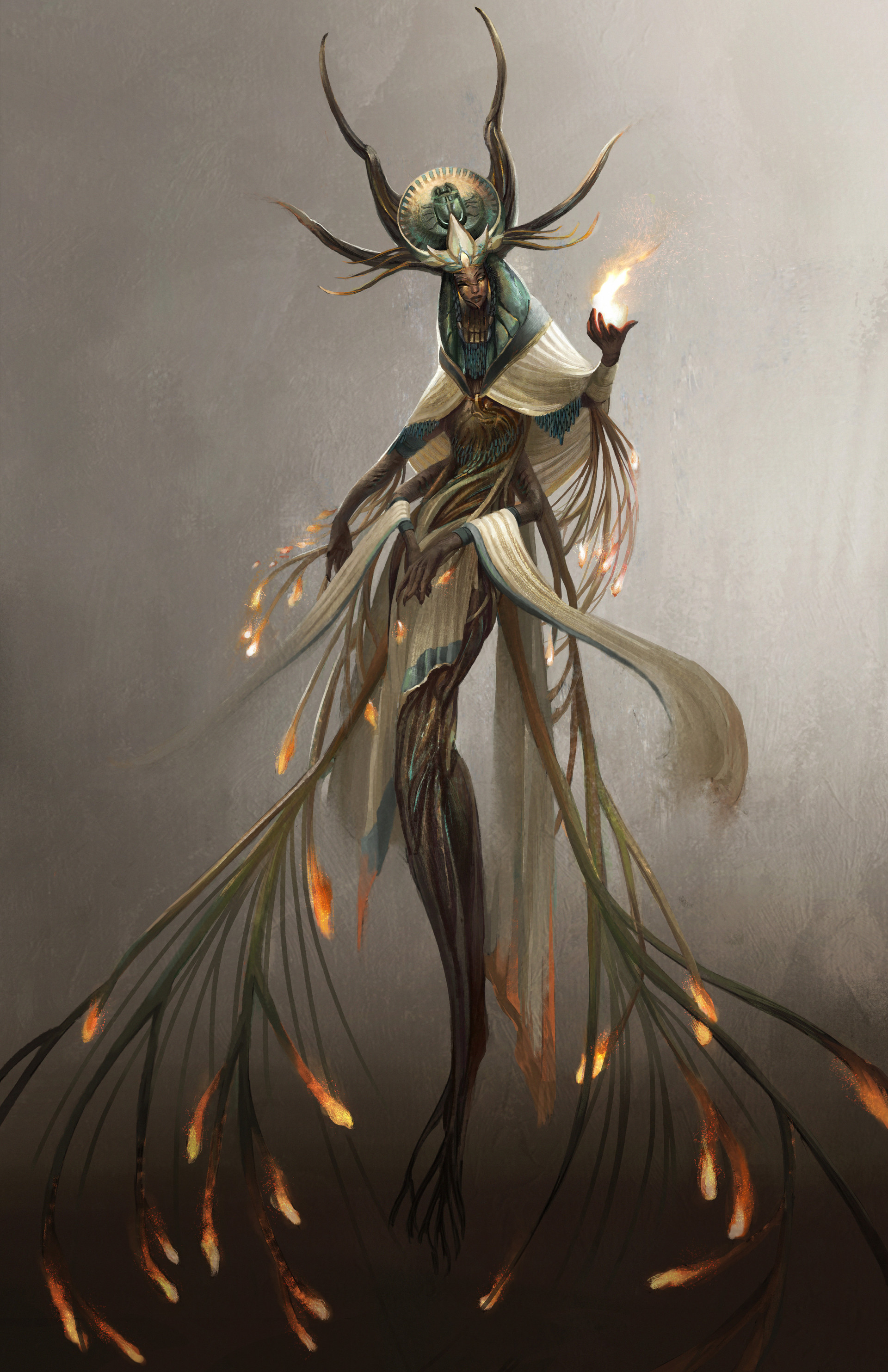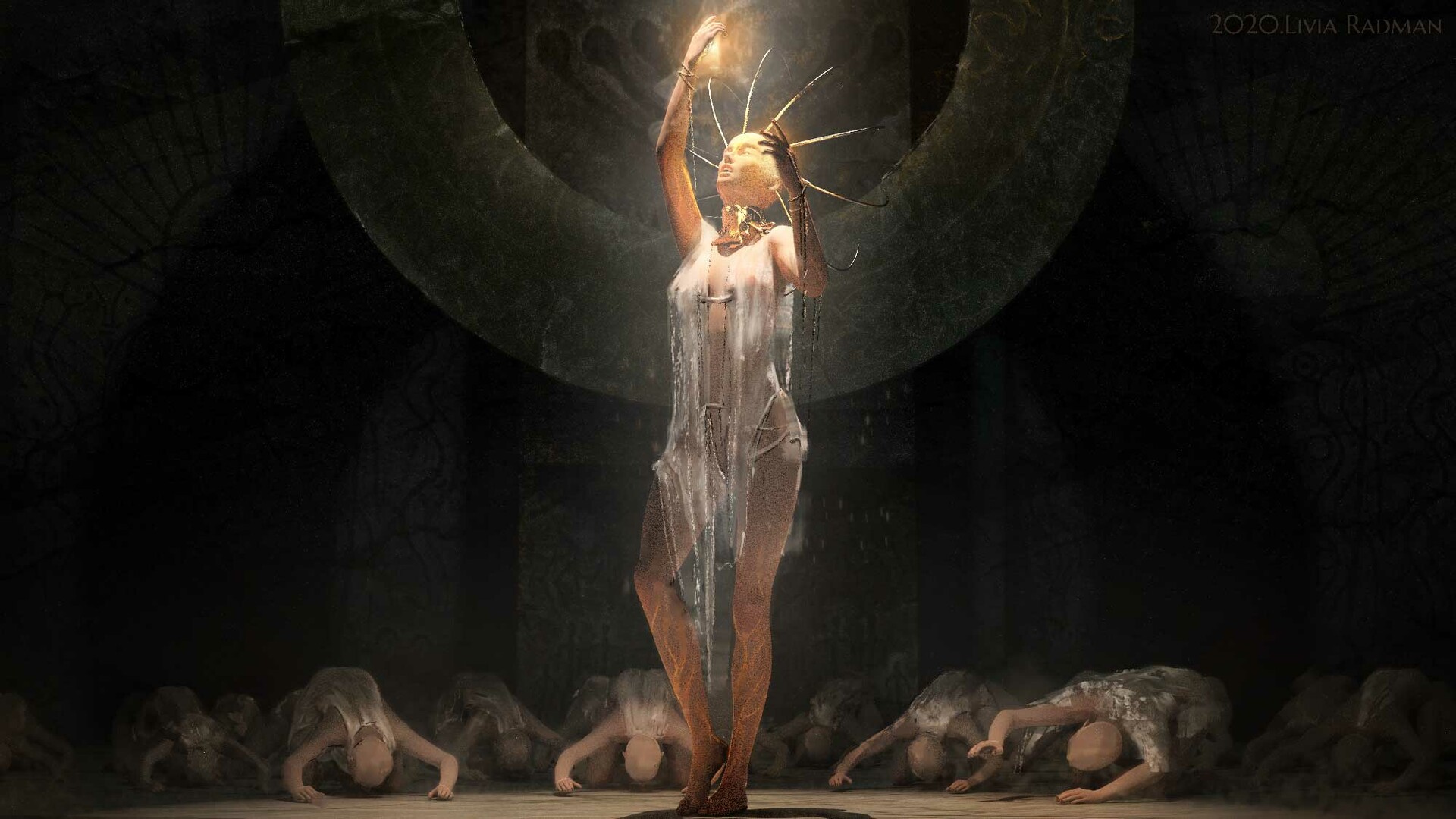Siblings who were heroes in their time, each was dedicated to a holy pursuit and exemplified it to an incredible degree. It has been decades since then, and they are considered holy figures. Especially for adventurers or other outsiders to normal society, the saints are an excellent way to pursue faith, along with strong personal virtues and goals to align with.
A depiction of the saints can be identified most easily by a golden body part, differing depending on the saint in question. An image of a woman with chaotic golden lines along her skin however is blasphemy, and is often a sign of great evil.
Yashtas, Saint of Song
Weaver of the saints' many tales, throughout her life she struggled to spread her name without losing her sense of self, or becoming distorted in the minds of the public. Sometimes those who inherited her charge seek only personal fame to the exclusion of all else, and are warned by her teachings about the risks of such behavior.
Body: tongue
Symbols: purple, crescent moon, snapdragon, quartz, peacock, rapier
Task: grow your reputation, leave memories
Boon: speak a message to any people you can see, which they will surely hear even if whispered amid a storm.
 |
| Priestess, by Mahealani Rodrigues |
Ishrar, Saint of Roads
Never satisfied in one place for long, Ishrar saw many lands and tried always to leave any place she visited better than she found it, a difficult feat at times. Her followers are almost all nomads, and oftentimes traders though she mainly lived on the land.
Body: feet
Symbols: orange, cooling wind, daisy, opal, deer, spear
Task: come to a place you’ve never been
Boon: your step is sure, and you will not tire until you next stop walking.
Amarin, Saint of Battle
A mistress of weapons and all manner of fighting styles, she sought power but struggled with an inner rage that often drove her to unwarranted violence. It is thought that later in life she was able to find peace, but to this day many of her followers seek only might and care little for the restraint she tried to uphold.
Body: teeth
Symbols: red, black cloud, carnation, ruby, tiger, lance
Task: defeat a worthy foe in deadly combat
Boon: you can carry one weapon without encumbrance for a week.
 |
| The Last Step, by Ignis Bruno |
Meshar, Saint of Gardens
By far the longest lived of the saints, some say she still lives even to this day, hidden away deep in a labyrinth of flowers and herbs. As her teachings emphasize survival and health above other virtues, some think her followers to be cowardly. In truth, among them one can find some of the toughest, hardiest people imagineable.
Body: heart
Symbols: brown, gentle rain, sunflower, obsidian, carp, halberd
Task: go a week without injury
Boon: gain immunity to disease as long as you remain unharmed.
Zaraf, Saint of Libraries
Studious and soft-spoken, Zaraf spent so much time learning that she sometimes failed to make use of the knowledge she gained, and tried to hand down teachings to help others with that very task. Her followers are intended to be just as studious, though there is more variety in how and what they may study.
Body: eyes
Symbols: blue, starlight, hydrangea, sapphire, owl, dagger
Task: read a sizeable book
Boon: understand and read all languages for the rest of the day.
 |
| Ritual, by Livia Radman |
Sunesh, Saint of Weddings
Lascivious saint, partner and spouse to many, and with nearly as many appearances over the course of their life. Sunesh was known as a generous and lively person, sometimes to a fault. Followers of Sunesh are expected to venerate them in whatever form is personally preferred, as that is how they shared love in life, and the saint's teachings emphasize consent and sensitivity to a partner's (or potential partner's) desires or needs.
Body: hands
Symbols: pink, full moon, rose, emerald, dove, whip
Task: spend a night or day with a lover
Boon: for the rest of the week, you can tell if love is true.
Niket, Saint of Home
Amarin would be the first to tell you that Niket was stronger by far. However, Niket struggled to keep up with her siblings and eventually learned to build, her creations eventually becoming the city of Il Kamiyar, the Great Bridge. Her followers congregate their, but can also be found striking out elsewhere, to spread that industrious spirit.
Body: shoulders
Symbols: green, warm sunlight, orchid, peridot, sparrow, axe
Task: sleep within a building you helped create
Boon: you can lift one object and carry it, so long as you could drag it.
 |
| Alexandria the Black Mage, by Maika Sozo |
Tevresh, Saint of Blasphemy
Said to have betrayed her siblings, they cast her out and tried to erase her memory. However a memory cannot be so easily suppressed, and may only become more resilient with each attempt to exterminate it. Those scarce teachings that can be found from her time ecourage one to abandon their duties, reject any role or path set out for you and struggle alone if you must.
Body: scars
Symbols: black, new moon, windflower, howlite, moth, broken sword
Task: destroy a shrine, or kill a leader
Boon: the next time you could die, fate may be turned aside.
Notes
I've been trying to come up with ways to engage the player with the setting more, and a huge part of that is religion. Historically religion has always been a very important in life as well as fantasy, but it seems like a large portion of the gaming community (myself included), are atheistic, so that sense of worship and service to a higher power can be... off-putting. It creates a divide between the player and the average person in the game world, their analogue.
Thus I create instead aspirational figures, so that even the most power-gaming edgy anti-theist could start from a point of "oh yeah I want to be cool like that person," and then once the player is engaged with these figures I think it becomes easier for them to shift that engagement toward roleplaying something more spiritual or worshipful. I've been told that D&D also has demi-gods and high priests and what not, but that doesn't really address this rift between the player and the average character in the world, instead making it probably wider by suggesting that we roleplay worshipping something that isn't even a god? It feels strange.
Oh hey, Skerples recently made a few blog posts about saints and gods and all that jazz. Hope they like this (or at least see it).
cool
ReplyDelete